When my father John Maeckle died in 2015 at the age of 93, we celebrated his life with the release of 93 monarch butterflies. The low-key ceremony in the butterfly garden of our home with family and friends was “better than church,” according to my mother Hilde Maeckle, his surviving 87-year-old partner. For weeks, every time I’d see a monarch along the San Antonio River, I’d tell myself “that’s Opa’s butterfly.”
The thought gave me hope, inner peace, and a sense of reassurance.
Ever since, whenever I hear news of a loved one’s passing, I suggest we tag a butterfly in the person’s name come autumn. The individual who lost someone always smiles and agrees this is a good idea.
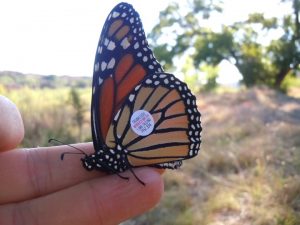
This year’s Monarch Butterfly and Pollinator Festival will honor the dead by tagging a monarch butterfly in their name. Photo by Monika Maeckle
Each fall, citizen scientists like me tag thousands of monarch butterflies as they funnel through Texas. We snag butterflies in our nets, gently grasp them, and adhere a tiny, round sticker to the discal cell of their wing. We record the date, sex of the butterfly, location, and the name of the person who tagged it before releasing it to the winds to join the annual monarch butterfly migration. We submit that data to Monarch Watch at the University of Kansas.
This year, however, in addition to the usual data collected, we’ll record the name of someone who died, as a way to honor their life.
The possibility that a butterfly tagged in San Antonio will find its way to the Mexican mountains to continue the life cycle offers a small gesture of hope and healing–both in short supply this year.
That’s what drives our 2020 Monarch Butterfly and Pollinator Festival. We’ll still educate the community on the citizen science of the monarch migration and encourage people to plant pollinator habitat. But this unique, difficult year calls for us to focus on the hope the monarch butterfly migration represents.
Millions of monarch butterflies move through the Texas Funnel each fall on their way to their overwintering roosts in the Mexican mountains. San Antonio, named the nation’s first Monarch Butterfly Champion City by the National Wildlife Federation in 2015, sits in the heart of this migratory flyway. The monarch migration is just starting in Canada and Minnesota. In the Alamo City, peak monarch migration season runs October 10 – 22.
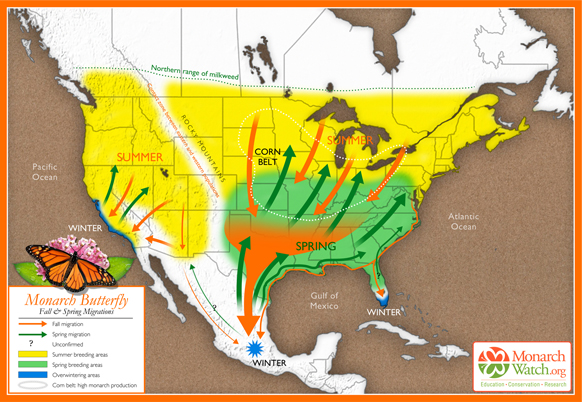
Monarch butterflies leave their roosts in Mexico each spring and migrate over multiple generations to Canada, returning to Mexico in the fall. Graphic via Monarch Watch
That’s why San Antonio’s annual Monarch Butterfly and Pollinator Festival, founded in 2016, is staged here each fall. For the past four years, a public-private partnership has organized myriad events–workshops, lectures, movies, art exhibits and panel discussions that raise awareness and appreciation of insect and wildlife pollinators. They are, after all, the essential workers that make one of every three bites of our food possible. They also symbolize our inherent cross-border connectedness, from Canada to Mexico.
The Festival has always consummated in a gathering of thousands of people at Pearl where children and families learn the how and why of tagging monarchs, a citizen science initiative started by Monarch Watch at the University of Kansas at Lawrence.
But COVID-19 forced a reset of our fifth annual Festival. We’re taking it online and focusing on the monarch migration’s spiritual dimension.
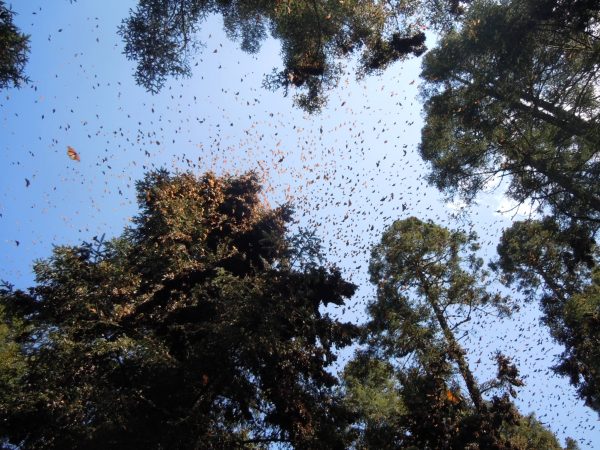
Millions of Monarch butterflies at their Mexican roosts. Photo by Monika Maeckle
Butterflies have long been associated with the souls of the dead. In Mexico, migrating monarchs typically arrive in the mountains west of Mexico City just in time for Día de los Muertos, or Day of the Dead, which falls on November 1. These tiny creatures of transformation arrive at the high elevation forests by the tens of millions as ambassadors of hope, sorrow and passage to the next stage. The mariposa monarca reminds us all that life and death are a cycle, one of birth, change, and rebirth.
The metaphor of the monarch couldn’t be more apt in this year of pandemic and great social unrest.
As COVID-19 death counts mount and the number of social injustice victims climbs, few opportunities exist for the communal mourning of our losses. Gatherings of more than 10 people are prohibited. Hugs are out, physical contact limited or forbidden. Business is brisk at local funeral homes, where the bodies of loved ones can sit for two weeks in a refrigerator truck waiting their turn for a memorial service due to increased demand.
The butterflies we tag and release this year will catch wind currents and draft each other all the way to Mexico. Their great- great-great-grandparents started this multi-generation journey high in the Mexican mountains in the spring of 2020, around the same time COVID-19 hit San Antonio. And while our tagged butterflies will never have pumped their wings anywhere near this remote patch of forest, they somehow will find their way there this fall.
They’ll roost for the winter. In the spring, they’ll mate. The females will head north in search of milkweed to lay the first generation of eggs, often in Texas. The life cycle continues.
In the past three years, eight butterflies tagged at our Festival have been recovered and reported. We’re hoping for more this year.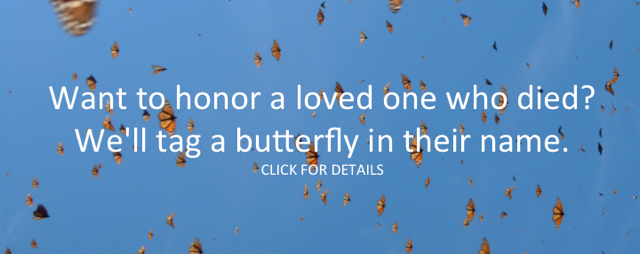
Wouldn’t it be a sweet and hopeful sign if your loved one’s butterfly made it to Mexico? Help us remember your lost family member, friend, or co-worker by name. Simply fill out the form above, or at this link.
ARTWORK by José Sotelo
Related Articles
- Monarch Butterfly and Pollinator Festival to remember those lost in 2020
- Three monarch butterflies tagged at 2018 Festival recovered in Mexico
- Thousands gather at Pearl to close out fourth annual Monarch Butterfly and Pollinator Festival
- Waggle Dance Anyone? Learn how at Monarch Butterfly and Pollinator Festival‘
- Bat Man of Mexico’ to appear at Monarch Butterfly and Pollinator Festival
- NPR immigration correspondent John Burnett to appear at Butterflies w/o Borders Forum
- Here they come! Monarch butterflies heading south in what could be a late, great migration
- Monarch expert Dara Satterfield to appear at Butterflies without Borders Forum
- Butterflies without Borders: Monarch Butterfly and Pollinator Festival to take flight Oct. 12 – 20
- Author, naturalist David Mizejewski to appear at Monarch Butterfly and Pollinator Festival
- San Antonio’s 300for300pollinator habitat initiative expands to 500 by 2020
- Popularity of pollinator gardens growing in areas prone to drought
Like what you’re reading? Don’t miss a single article from the Texas Butterfly Ranch. Sign up for email delivery at the bottom of this page, like us on Facebook, follow us on Twitter, @monikam or on Instagram.

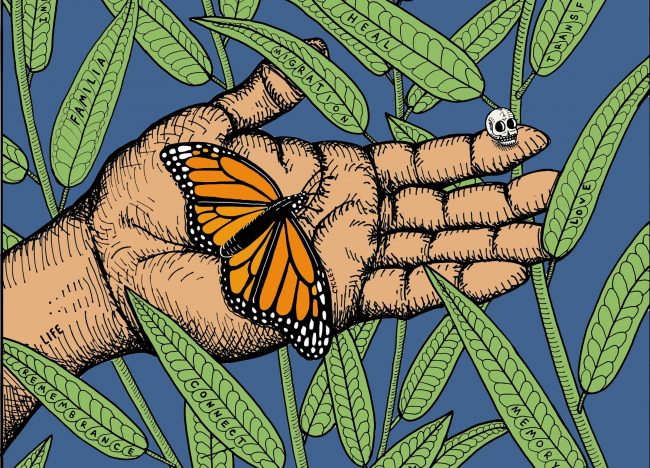
Beautiful story, Monika, and a wonderful way to honor those we love who no longer walk on the earth with us
Thank you, Zet. I agree. –MM
What a beautiful way to remember a loved one. I will miss the fun and excitement of the Butterfly Festival at the Pearl but look forward to seeing the event online.
Thanks, Candy. I’m hoping our audience is event bigger this year, thanks to the virtual aspect. Hope to “see” you at some of our events! –MM
What a heartwarming tribute to your Dad Monica! Glad to see you leading the Butterfly Festival. God bless and stay safe!
Bob Thomae
Thomae-Yndo Ranch
Canada Verde, Texas
Thank you for the kind words. Hope you will join us online at some of our events. –MM
Releasing or tagging in memory of someone is a beautiful thing to do. Sad that you had to add social injustice or causes to the post.
Monika,
Love the new website re-design! Also this piece. Hoping you can get some names for the festival.
Best,
Rocío
I have either a Queen or a Monarch caterpillar on the milkweed plant in my yard. Thanks for the ID info. I will have to get a closer look and try to send you a pic, now that I have positive ID CLUES. Alice DeBolt, La Jolla, Ca.
My husband, Donald Ayers, recently passed away. He loved Monarch butterflies and we have planted a
butterfly garden with milkweed. The Monarchs passed on their way to Mexico and stayed overnight at
our acreage in Oklahoma. I would very much like to mark a Monarch with his name. He would be so very
honored. Thank You, Carole Ayers
Carole, we are so sorry for your loss. Please fill out the form at this link:
https://texasbutterflyranch.com/forever-journey/
and we’ll be happy to tag one for him. Best wishes to you. —MM